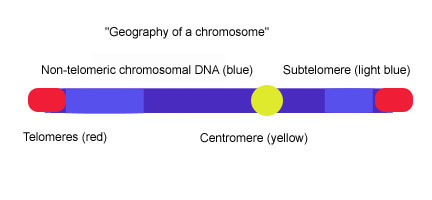
Subtelomere
Encyclopedia
Subtelomeres are segments of DNA "sub-" or "below" telomeric caps. Telomeres are specialized protein
-DNA
constructs present at the ends of eukaryotic chromosomes, which prevent them from degradation and end-to-end chromosomal fusion. To conceptually introduce telomeres, introductory biology courses often describe them as a type of chromosomal aglet
.
Most vertebrate telomeric DNA consists of long (TTAGGG)n repeats of variable length, often around 3-20kb. Loss of telomeric DNA through repeated cycles of cell division is associated with senescence
or somatic cell aging. In contrast, germ line and cancer
cells possess a telomerase
enzyme
which prevents this telomere degradation and maintains telomere integrity, causing these types of cells to be very long-lived.
Subtelomeric chromosome regions
are immediately adjacent to the long (TTAGGG)n repeats and also contain repetitive stretches of DNA. In the context of chromosomal analysis, subtelomeres are considered to be the most distal (farthest from the centromere
) region of unique DNA on a chromosome.
Recently, subtelomeres have garnered increased attention as research has implicated unbalanced subtelomere rearrangements as a contributing factor in idiopathic
mental retardation
and other genetic disorders.
Although not drawn proportionately to scale, this image should provide some idea of chromosomal geography.
Protein
Proteins are biochemical compounds consisting of one or more polypeptides typically folded into a globular or fibrous form, facilitating a biological function. A polypeptide is a single linear polymer chain of amino acids bonded together by peptide bonds between the carboxyl and amino groups of...
-DNA
DNA
Deoxyribonucleic acid is a nucleic acid that contains the genetic instructions used in the development and functioning of all known living organisms . The DNA segments that carry this genetic information are called genes, but other DNA sequences have structural purposes, or are involved in...
constructs present at the ends of eukaryotic chromosomes, which prevent them from degradation and end-to-end chromosomal fusion. To conceptually introduce telomeres, introductory biology courses often describe them as a type of chromosomal aglet
Aglet
An aglet is a small plastic or metal sheath typically used on each end of a shoelace, cord, or drawstring. An aglet keeps the fibers of the lace or cord from unraveling; its firmness and narrow profile make it easier to hold and easier to feed through the eyelets, lugs, or other lacing...
.
Most vertebrate telomeric DNA consists of long (TTAGGG)n repeats of variable length, often around 3-20kb. Loss of telomeric DNA through repeated cycles of cell division is associated with senescence
Senescence
Senescence or biological aging is the change in the biology of an organism as it ages after its maturity. Such changes range from those affecting its cells and their function to those affecting the whole organism...
or somatic cell aging. In contrast, germ line and cancer
Cancer
Cancer , known medically as a malignant neoplasm, is a large group of different diseases, all involving unregulated cell growth. In cancer, cells divide and grow uncontrollably, forming malignant tumors, and invade nearby parts of the body. The cancer may also spread to more distant parts of the...
cells possess a telomerase
Telomerase
Telomerase is an enzyme that adds DNA sequence repeats to the 3' end of DNA strands in the telomere regions, which are found at the ends of eukaryotic chromosomes. This region of repeated nucleotide called telomeres contains non-coding DNA material and prevents constant loss of important DNA from...
enzyme
Enzyme
Enzymes are proteins that catalyze chemical reactions. In enzymatic reactions, the molecules at the beginning of the process, called substrates, are converted into different molecules, called products. Almost all chemical reactions in a biological cell need enzymes in order to occur at rates...
which prevents this telomere degradation and maintains telomere integrity, causing these types of cells to be very long-lived.
Subtelomeric chromosome regions
Chromosome regions
Several chromosome regions have been defined by convenience in order to talk about gene locations. Most important is the distinction between chromosome region p and chromosome region q...
are immediately adjacent to the long (TTAGGG)n repeats and also contain repetitive stretches of DNA. In the context of chromosomal analysis, subtelomeres are considered to be the most distal (farthest from the centromere
Centromere
A centromere is a region of DNA typically found near the middle of a chromosome where two identical sister chromatids come closest in contact. It is involved in cell division as the point of mitotic spindle attachment...
) region of unique DNA on a chromosome.
Recently, subtelomeres have garnered increased attention as research has implicated unbalanced subtelomere rearrangements as a contributing factor in idiopathic
Idiopathic
Idiopathic is an adjective used primarily in medicine meaning arising spontaneously or from an obscure or unknown cause. From Greek ἴδιος, idios + πάθος, pathos , it means approximately "a disease of its own kind". It is technically a term from nosology, the classification of disease...
mental retardation
Mental retardation
Mental retardation is a generalized disorder appearing before adulthood, characterized by significantly impaired cognitive functioning and deficits in two or more adaptive behaviors...
and other genetic disorders.
Although not drawn proportionately to scale, this image should provide some idea of chromosomal geography.

External links
- The flow of genetic information -- PDF file. See Table 5.5

